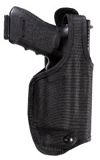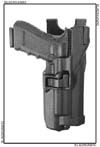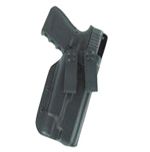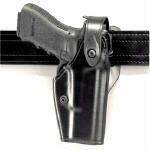By Ralph Mroz
One of the good trends that seems to be gaining traction now is the pistol-mounted light. A decade or so ago, before the advent of the now-ubiquitous accessory rail on pistols, there were methods and products for attaching a compact high-intensity light to various pistils, and to a limited extent they worked. But in addition to the size they added to the pistol they tended to be somewhat clumsy, they altered the balance of the pistol considerably, and finding a holster to accept the pistol-light combination was not easy. And if you go back to the dark ages (sorry!) before we had small high-intensity lights—back to the days of the multiple C- or D-cell lights—then your options for practical pistol-mounted lights were bubkis.
Now of course, with the wide-spread availability of rail-mounted lights such as the Surefire X200, the Insight M series, and the Blackhawk Xiphios, pistol-mounted lights are, while not the usual thing we see on belts, hardly unusual. A few years ago it began to be not-uncommon to see pistols with rail-attached lights on the hips of tac team members, both on call-outs and (if not full-time SWAT) in uniform. Today, while it’s not yet common practice, we don’t look twice when we see these units on any patrol officer’s hip. Some departments today even equip every officer with these lights (see sidebar.) Finally, for officers who are pretty much defined as having one hand normally busy—K9 and mounted officers, for example—a pistol-mounted light is a necessity if they are to see in the dark with their gun drawn.
Lights of a Different Breed
A pistol-mounted light is not a replacement for a hand-held light. They cannot perform the same functions (although there is some overlap) and neither negates the need for the other. If you have a light on your pistol, you still want to carry a small high-intensity light on your belt (on your off-side), and yet another in your gear bag. Why? Several reasons.
For non-threat activities, like examining a drivers license or looking into a car, or non-threat searches, you hardly want to be doing these with not only a gun in your hand, but with that gun pointed at people who are presenting no threat to you. You still need an independently operated light for these sorts of routine activities.
If you are engaged in a search or challenge that requires your gun to be out, using your pistol-mounted light to do that activity requires (or severely risks) that you “search (or challenge) with the muzzle,” which is neither safe nor proper for most civilian law enforcement activities. Remember that current (and proper) doctrine dictates that we don’t point muzzles at people unless we are in the act of shooting them (with some exceptions). Challenging suspects or searching for them are activities that are usually properly done with the gun in a ready position and the muzzle pointed in a reasonably safe direction under the circumstances.
Also, if you are searching with the muzzle and suddenly discover your suspect, and he doesn’t present a threat to you, startle response may cause you to shoot him nonetheless. (If you are too tough, too macho or too arrogant to think that you’d never succumb to startle response, well…for the sake of argument, I’m sure you’ll likewise agree that not every good cop is as fine a specimen of icy nerve control as you are.) Now, of course, you can search with the periphery of the pistol-mounted light, holding the gun in a low ready position. This technique actually works very well. However, there is a tendency under stress, after searching for a while, and for officers not extensively trained in this technique, for the muzzle to instinctively rise into the area you are looking into.
- If you want to use a “light and move” search technique, particularly if you have been trained in the ground-breaking techniques of Strategeos International, it’s all but impossible to do so with a pistol-mounted light. Double that if you also want to be safe during the search and not shoot an innocent or your partners.
One place of a pistol-mounted light, in my opinion, is in the control phase of a close-quarters search or suspect engagement. It’s during that period in which you are holding the bad guy at gunpoint for cuffing, spraying or Tasering by another officer, or challenging him. Here not only is the light best operated in constant-on mode (that is, no stealth is required on your part), but the muzzle and light are quite properly in alignment, and your other hand may be busy with a radio or other equipment. The pistol-mounted light is also a great tool when you want to get off a precise shot in low-light conditions. This happens when you have to take a long shot (say, past 12 or 15 yards), or when you can afford to give away your position with a light illuminated for longer than a “blink” slice of time because you are behind cover.
By contrast, searches in most buildings involve searching and eventually finding the suspect in normal room-sized areas (there are exceptions.) In this situation, with you exposed and him not far away, one-handed target-focused shooting will usually solve the problem while you power down the suspect with blinding light from your hand-held unit.
A pistol-mounted light is a shooting aid in general, and is used in situations in which you think or are sure a shot may need to be fired. It is used to identify the target and help you to get rounds on it. A flashlight by contrast, is a general-purpose “seeing” instrument. All-in-all, pistol-mounted lights are an extremely useful tool. Officers, teams and agencies that have adopted them don’t go back. Getting accurate shots on target is much easier and more intuitive when using them. What follows is a look at some of the holsters available for them. This is not an exhaustive list, but rather a sampling of what’s available from the major suppliers in mid-summer. These products represent the highest level security holsters—both duty and concealed—that the following vendors (in alphabetical order) offer for pistols with attached lights.
Security levels
But first a word on security levels themselves. Each manufacturer has a different method of assigning security levels to their holsters—there is no universally accepted industry standard. Most manufacturers, in an effort to “up” the level of their holsters, will even count tension screws as a security level. The system I use here is simple, practical and easy to understand. (Bill Rodgers of Safariland, the father of the modern security holster, uses a different, equally practical categorization scheme. A DVD is available from Safariland explaining it.) By my definition, a security “level” is achieved by an independent movement that you must make to get the pistol into a state whereby it can be withdrawn straight out of the holster. Thus, a speed scabbard (an open-top) holster is a level 0 holster. A simple thumb-break holster is a level 1, and any other independent movements necessary to draw the gun straight out of the holster add a security level each.
My reasoning is that it’s the number of independent things that must be manipulated that make it difficult for a bad guy to get your gun out of its holster. Thus my definition is meant to correspond to the actual level of security that the holster gives you in a grab situation (as opposed to some characteristic of the holster itself.) In most cases this is true, but below, you’ll see one “level 0” holster (by my definition) that actually is extremely secure. Nothing’s perfect. Holsters that accept pistol-mounted lights tend to have fewer security levels than others because many security mechanisms work by capturing the trigger guard. Since a rail-affixed light is wider than the trigger guard, in order to be able to insert the gun/light unit into a holster, a trigger guard mechanism often can’t be used.
There’s nothing wrong with a lower security level on a holster. There’s an inherent trade-off between security and draw speed. Many officers, and many trainers, prefer the speed and intuitive operation of a level 1 thumb-break holster over the security and complexity provided by level 3 and level 4 holsters. Heck, Bill Jordan spent most of his time on the Border Patrol with his Jordan-style duty holster in level 0 mode! (But see the sidebar for a differing opinion.)
Bianchi
The Bianchi Luminator is level one (thumb-break), straight-drop duty holster made from Bianchi’s AccuMold ® Elite™ technology. AccuMold is a synthetic product that looks like leather but is up to 50% lighter, less expensive. It really does look and feel like leather, but doesn’t require any break-in or stretching. It’s considerably abrasion-resistant, and can be cleaned with soap and water. The Luminator is designed around the Insight M3 size lights, and is available with plain, basket-weave or nylon finishes. The bottom is closed around the light bezel to protect it, and open at the muzzle to allow debris to fall free. It employs Bianchi’s ErgoTek padded belt loop which cinches with two tension bars to a duty belt with Allen head screws.
The Luminator is lined with Coptex, a nylon-like material that provides good “glide” to the pistol. The Bianchi Vision is an un-lined leather holster version of the same body design as the Luminator, and is likewise a level 1 thumb-break holster. Its sewn belt channel provides a forward tilt to the holster in strong-side carry, while the channel used with an integral slot provides a crossdraw angle. Both the Luminator and the Vision are basic, well-executed level 1 holsters, made from excellent materials.
|
Blackhawk
Blackhawk’s “Level 3” SERPA Light Bearing Duty Holster does in fact incorporate two high-security features into its design, but the holster is so cleverly designed that it’s closer to a Level 0 holster by my definition. How is this possible? It’s because of the nature of the two active retention devices. The SERPA trigger-guard retention device is naturally and automatically released by your index finger during the drawstroke, and the hood retention device is naturally and automatically released by your thumb during a proper drawstroke. So, if you draw your gun with the index (trigger) finger straight forward, and your thumb high and forward (as it should be), both devices are automatically released. And yet the holster is very secure against unauthorized grabs since only the wearer is in a position to easily release the mechanisms. World-class shooter Todd Jarrett says that when he started using this holster it made him a better shooter since it forced him to acquire a proper grip on the gun every time! Made of 100% hard synthetics, this holster is very secure and yet very easy to release.
Bladetech
|
Over the last decade Bladetech has grown from Tim Wegner’s one-man shop and pioneer in the use of Kydex for knife sheaths, to a small shop making Kydex holsters, to a major player in the business. If you haven’t figured it out already, synthetics are the wave of not just the present, but the future. Leather these days is now mostly for die-hards, nostalgics and a few specialized concealment applications (for example, a leather inside-the-waistband (IWB) holster offers grab-resistant security above that of synthetics. The Bladetech catalog currently offers three dozen holsters, orderable with a menu system of options. Bladetech offers nine light-accepting holsters, with options—both IWB and belt holsters. The highest level security on a Bladetech belt holster for a pistol with light is level 1—a traditional thumb break. However, Bladetech also makes something unusual: IWBs for pistols with lights. You may think that a light adds too much bulk to be carried with its gun in an IWB, but the Bladetech Tactical Light IWB will prove you wrong. Although it is a level 0 holster (an open-top scabbard), remember that this is a concealment holster, and should not be seen. This holster is just what you would expect from Bladetech: perfect fit, top-level materials (including synthetic adjustable belt snap-loops), an intelligent and functional design. It comes with an FBI cant and two tension screws, and it’s comfortable and works great! If you think a light/pistol IWB can’t work, try this one. For Glocks and 1911s with the Surefire X200 only.
DeSantis
Gene DeSantis and his crew keep coming up with clever ideas. Their T64 Kydex Tac-Lite holster is a case in point. It is a well-executed Kydex holster for popular pistols, accommodating an M3-size attached light. With its synthetic thumb-break straps, it is a level 1 holster. Here’s where the clever part comes in: remember that I earlier said that most holsters for pistol-mounted lights have to forego a trigger-guard capturing security mechanism? Well, for that same reason, most of these holsters also have to forego a mechanism that secures the pistol in the holster when you simply place the pistol into the it (a mechanism other than simple tension, that is.) That’s because most of these retaining mechanisms, which are usually spring-principle operated, rely on a “catch” that catches on the trigger guard. Well, the Tac-Lite has a Kydex spring that captures a portion of the attached light itself, meaning that if you simply drop the gun into the holster, it won’t fall out, even with the thumb-break straps unfastened, unless it’s pulled up. While this does not constitute a security level, it is a highly desirable feature in a real-world tactical holster. The T64 comes in 3 variations: a concealment version, a duty version, and a thigh version; the holster body is the same in all three cases. The concealment version incorporates DeSantis’ asymmetrical belt channel, which pulls the butt of the pistol into the body, and it works effectively.
Don Hume Leather goods is an Oklahoma-based duty and concealment holster manufacturer that continues to emphasize its leather capabilities and product lines, although they do make a good selection of ballistic nylon duty gear, too. In addition to the two pistol/light holsters described here, they also make a shoulder holster for a light pistol in case that’s your preferred mode of concealed carry. The H722TAC (Don Hume doesn’t go for sexy product names!) is a level 1 slot-and-loop style concealment holster with a thumb break. This straight-forward high-ride unit is all leather and comes unlined and well-executed. The NH738-SHTAC is a ballistic nylon duty version of a level 1 thumb-break pistol/light holster. Don Hume’s ballistic nylon encloses a non-woven polyethylene fabric, which allows the fabric sandwich to become rigid when heat-molded. This attractive holster encloses the light bezel while retaining an open muzzle bottom. It’s available with in a traditional jacket-slot attachment or a sewn high-ride direct belt attachment configuration. The Hume holsters are available for a variety of lights.
Gould & Goodrich
Safariland
|
Safariland is probably the most common light-accepting holster on the market. Safariland is the “big boy” in the duty holster industry and their products are used by law enforcement and military units on a large scale world-wide. They have an extensive R&D capability, and employ a roster of famous shooters who provide insight and feedback on new designs. The Safariland product lines are extensive, and the catalog can be confusing. In addition to the various product lines, most products have variations and options, some of which work together, and some of which are mutually exclusive. And there are various finishes to choose from, too. The highest level pistol/light holster in the Safariland line-up is the 6280. This holster can be configured in either a 1+ or 2+ security level (using my security level definitions—see above.)
The primary security mechanism is the SLS rotating hood that you’ve probably all seen. This “hood”—much like a strap—can rotate forward off the top of the gun when its release mechanism is depressed. It provides (by my definition) a 1+ security level, since there is a single, but multi-part, independent motion (depress and rotate) required to get the gun into “just pull up” mode. You can add the Safariland Hood Guard, which offers no security retention, but does make a gun grab from the front more difficult. If you want to add another security level, to bring the holster up to a 2+ level, you can add the Sentry. which is a lever that block the hood’s release mechanism until it is rotated back. Thus the draw stroke on a 6280 so equipped would involve the thumb rotating back the Sentry, then depressing the hood release, then rotating the hood forward, then the entire hand drawing the pistol/light. The 6280 is available in several of the high-tech Safariland synthetic materials, and in multiple finishes. These wonder materials are soap-and-water cleanable, non shape-deforming, abrasion-resistant, precisely molted and highly durable.
Safariland also makes a speed-scabbard concealment rig for a light-bearing pistol, the 5187. This open-top Safari-Laminate™ holster incorporates suede lining and low cut sides. The injection-molded belt slots are configurable for belts from 1.5-inches to 2.25-inches.
Uncle Mike’s The EVO3 from Uncle Mikes is a new duty security holster for light-bearing pistols. It incorporates an ejection port lock and a rotating hood, but since both are released by the depression or a thumb-activated lever, it is a Level One holster by my definition. This hard-bodied holster is available for popular Glock pistols and for the Insight and Glock lights, in three finishes.
More Information
Bianchi InternationalP.O. Box 9015
Temecula, CA 92589-9015
(951) 676-5621
Blade-Tech Industries
2506 104th Street Court South
Building H
Lakewood, WA 98499
(877) 331-5793
DeSantis Holster & Leather Goods Co.
431 Bayview Avenue
Amityville, NY 11701
(800) 424-1236
Don Hume Leathergoods
P.O. Box 351
Miami, OK 74355-0351
(800) 331-2686
Safariland, Inc.
3120 E. Mission Blvd.
Ontario, CA 91761
800-347-1200
Strategos International L.L.C.
1024A Jib Court
Lee’s Summit, MO 64064
(888) 569-5444
















